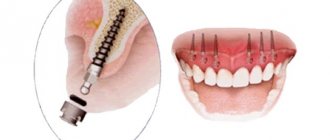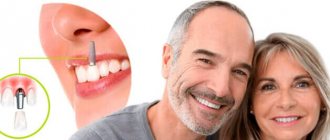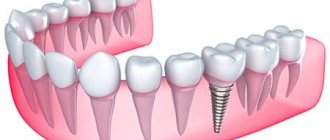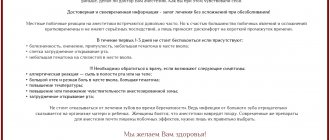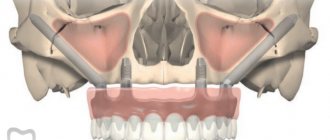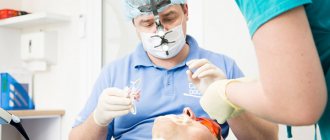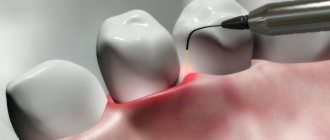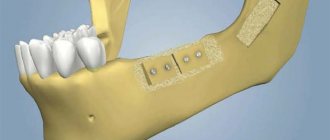What is the essence of the method
The considered method of replacing missing teeth involves the installation of six two-piece implants with a special type of abutment. Two implants are implanted in the front area of the jaw, while the remaining four are fixed in the lateral areas, in the area of the chewing teeth. Preliminary bone grafting is not required, because the implants are installed on the sides at an angle, which makes it possible to minimize the risk of injury to the nerves and sinuses.
Implantation using the all-on-6 protocol
It is interesting that sometimes (if the doctor knows this technique and if the patient has pronounced bone atrophy), zygomatic implants can be additionally used on the upper jaw. They reach a length of 5-6 cm and are attached to the cheek bone, which is located in the cheek area and in front of the ears. It is incredibly strong and does not undergo changes in volume and structure, so with this approach it is often used for attaching implants.
For information: 2, 4 or even all six zygomatic implants can be used as part of this protocol. Their introduction, of course, significantly increases the cost of implantation. But at the same time, it allows us to solve the problem of extremely pronounced atrophy, which is a very, very significant plus.
“I have been struggling with my teeth since childhood. For as long as I can remember, I constantly wandered around dental clinics. But time passes, I’m not getting any younger, so at some point the question arose about a radical solution to the problem. After a long study of all possible options and communication with specialists, I chose implantation using the all-on-six method. It was, of course, scary, because all my friends who have implants said that the treatment was very long, but then they promised that in a week I would be walking with new teeth. Honestly, I was incredibly happy and impressed that after 5 days I was fitted with a prosthesis, which, by the way, is very cool and doesn’t stand out at all. While I’m still going with him, about a year has passed. In general, everything is great, I’m just happy! And I sincerely don’t understand those people who are forced to wear removable dentures after they received implants, because there are such excellent methods!!!”
Marina, Moscow, fragment of a review on the website irecommend.ru
The treatment protocol under consideration refers to one-stage implantation methods. A non-removable orthopedic structure is usually fixed within a few days after implantation. Such an impressive rate of treatment allows the patient to return to a normal lifestyle in the shortest possible time.
An innovative approach to dentistry or how to start chewing right away
Implantation in cases of complete edentia (when there is a history of a mouth without teeth), in the absence of a large number of chewing and front teeth in the lower jaw, should provide a person with maximum comfort with minimal time and money. Agree that new teeth in the lower jaw, like lost ones, should be as functional as possible, suitable for eating, for grinding food, their main purpose is to make active chewing movements. They should also be ready for stress not a year after visiting a doctor, but immediately, otherwise how can one even talk about a full-fledged lifestyle.
Fortunately, patients today have such an opportunity - these are one-stage implantation methods with immediate loading with a prosthesis, which, by the way, in 90% of all cases make it possible to do without building up bone tissue at all, even if it is of poor quality, inflammation or insufficient volume. There is not just one method, there are several of them - as they say, for every taste, color, situation and budget. In general, they differ in the number of supports or implants installed under the prosthesis - the quantity, brand and method are determined by a specialist based on an assessment of the quality of the bone tissue. This is done using computed tomography of the jaw, with 3D modeling of the treatment process - the smaller the bone, the worse its quality, the more implants are required for a successful result.
Trefoil or three-implant prosthetics technique
The technology is presented by Nobel and involves the use of original Trefoil series implants, developed specifically for this complex. This is a separate technique that was developed and positioned specifically for restoring teeth in the lower jaw. The protocol takes into account the structural features of the mandibular joint, allows the patient to save money and gain the entire row at once. It uses only three implants and a prosthesis that restores up to 12 units. Artificial roots are installed only in the frontal region, because, as studies have shown, it is in this area that they atrophy the least.
Read more about the method in our separate article.
Solving the problem with four implants
Two of them are installed in the area of the chewing lower teeth at an angle, two in the frontal zone parallel to each other. The angular location of the lateral roots allows you to use a large area of bone tissue, use only the densest and most inflammatory layers, avoid bone grafting, and increase the strength of implant attachment to the bone.
Here patients have several options to choose from: the Nobel all-on-4 concept - all on 4 implants, or the Straumann Pro Arch. These are the only protocols that have truly proven themselves for restoring all teeth on exactly this number of implants. By the way, manufacturers do not limit the choice and often offer doctors to add 1-2 more implants, for example, in the frontal zone, if there is a need for this and the system will function better.
Also, under the auspices of “prosthetics on four”, you may be offered other models, for example, Osstem or Alpha Bio. They will help you save a lot, but be careful, because... the manufacturer does not have such an impressive research base compared to the original developers of the concept. Remember that the miser pays twice!
Six implant solution
This is another protocol - separate. In fact, based on the previous one using four implants. The name itself is a registered trademark of one of the Moscow clinics - the doctors of this particular dentist are responsible for the development of the all-on-6 protocol.
Read more about the technology in our separate article.
The technique is quite universal, because it allows you to restore teeth not only in the lower jaw, but also in the upper jaw. As the name implies, the number of implants is increased, so this solution is suitable for situations where bone atrophy is more pronounced.
Solution for Vivid Bone Atrophy
Here we are talking about increasing the number of implants, because the smaller the bone, the better the support for the implants should be. This applies to any jaw. Therefore, we are talking about a minimum of 8, maximum of 14 implants. This protocol is called basal implantation. The prosthesis, as in any other cases, is installed immediately. But it is held in place with cement fastening - this is more reliable. There are many implants, so the prosthesis is fastened well, there is no need to reposition it (in other situations, screw fixation is used).
Implantation of ALL-ON-4® on Nobel implants 6 months after treatment
“Before deciding on complex lower implantation, I collected information for a long time. I had consultations at three clinics, found out the cost, and asked about possible treatment methods in my case. The minimum price was 250 thousand rubles for immediate installation of the prosthesis and the maximum for a two-stage installation - 560 thousand rubles. In the end, I chose dentistry, where I immediately established contact and understanding with the doctor, where he did not fight off my numerous, meticulous and annoying questions, but gave detailed answers. Well, they treated me with four implants, which turned out to be quite affordable. By the way, they also gave us an installment plan. But in fact, I got a result that justified all the expenses, now I seem to be 7 years younger and I can even chew what was not always possible in my youth, since I always had bad teeth.”
Elena Konstantinovna, fragment from a review on the Dentistry.rf portal
Solution for those with periodontitis
The basal protocol is also worth considering for patients with pronounced problems, in addition to, of course, adentia: acute lack of jaw bone, periodontitis and periodontal disease, osteomyelitis. The method is also indicated for smokers and elderly patients. All this is explained by the fact that implants have a smooth surface, so even when in contact with the gums, plaque does not accumulate on them. In addition, the coating is antibacterial, which helps stop the inflammatory process.
In what cases is it used?
Among the indications for the use of this concept are the following conditions:
- complete edentia or absence of a significant number of teeth,
- average degree of atrophy, but in the upper jaw due to the addition of zygomatic implants, bone loss can be more pronounced, up to extremely low levels,
- inability to grow bone
- periodontal diseases,
- inability to use removable orthopedic structures,
- urgency of treatment.
Complete absence of teeth is an indication for implantation.
Implantation and prosthetics using this method are applicable only in cases where there is not very pronounced bone resorption. An acute lack of bone tissue in the lower jaw is a direct contraindication to treatment using this technology - six implants are not enough to ensure high-quality and durable fixation of the prosthesis.
Fixed prosthesis on 6 implants
For the purpose of implantation in the complete absence of teeth using the technology of dental implantation on 6 implants, in terms of price, the most optimal option is the implantation of 2 implants in the anterior segment of the dentition in the area of the third teeth, and in the lateral segments - 4 implants in the area of the fourth and sixth teeth .
At the same time, it is possible to install the outermost implants in an inclined position, so as not to affect anatomically significant areas - these are the maxillary sinuses and the inferior alveolar nerve.
If we consider fixed (without artificial gum) prosthetics on 6 implants, then the prosthesis is fixed using a screw fastening.
Thus, three separate bridge-like fixed prostheses are installed in the jaw, all on 6 implants.
In rare cases, it is possible to use two bridges on six implants in the form of half-horses for permanent jaw prosthetics. In this case, implants are installed in the area of the first, third and sixth teeth on each side of the dentition.
Implant models
To carry out implantation using the All-on-6 method, two-piece implant models are used. The presence of a special antimicrobial coating helps prevent the proliferation of harmful bacteria, which makes it possible to avoid the development of peri-implantitis1 and inflammation of soft tissues. However, this all depends on the brand of implants. For example, Nobel models have a unique porous TiUnite coating, Straumann are distinguished by the presence of a bioactive hydrophilic surface SLActive - it is largely thanks to such innovative developments that implants take root faster. These are the brands that are best suited for this protocol.
We mentioned earlier that zygomatic implants are also used for this method. They are in the line of the manufacturer Nobel and are called Zygoma (Zygoma). Among all similar models, they were the first to appear on the market, so the recommendations of experts boil down to the fact that it is best to choose zygomatic implants from the Nobel brand, because they are the best and have undergone numerous clinical studies.
Zygoma implants
In addition to the implants themselves, abutments are a mandatory element. They are mounted on top of titanium pins and are designed to fix the prosthesis. This approach uses innovative models: multi-unit. Firstly, they can be inclined. Secondly, multi-unit primarily means that such abutments are designed for screw fixation. What it looks like: they go inside the implant. But inside the abutments themselves there is also a cavity - for a screw that is screwed through the crown or prosthesis.
This is a very important aspect, because it is this approach that makes it possible to reline the prosthesis, and this will definitely be required at first, because the bone regenerates, is restored, and the structure is adapted to the patient’s bite. In addition, the prosthesis may be a little uncomfortable - so it can also be adjusted.
Features of the preparatory stage
The undeniable advantage of the “all on six implants” method is the ability to accurately simulate the treatment process using innovative computer programs. At the preparation stage, the patient will have to undergo a computed tomography scan, and the better the equipment, the better - this will allow the doctor to obtain the most complete data on the condition of the sinuses and bones.
After this, the obtained data is entered into a special program, with the help of which the optimal design model and places for installing implants are selected. This is called simulation or virtual treatment planning.
How is implantation performed?
One of the key differences between the All-on-6 technique and the All-on-4 protocol is the increased number of implants. This makes it possible to treat more pronounced atrophy and thereby improve the support of the prosthesis.
The installation of implants is carried out using a gentle method. The specialist makes small holes in the gum, through which he literally screws the implants into the bone, due to which they are securely held inside, and also a compression effect occurs - the surrounding tissues become denser. But this option is only possible if surgical templates are used - they are similar to mouth guards, only with holes.
Template method for installing implants
On a note! In the process of fixing implants, it is highly advisable to use special templates, which are silicone trays or stencils with small slits. Before installation, they are placed on the gums, and the implants are inserted through the holes. This allows the specialist to place the structures as accurately as possible.
If the classic fixation method is used (with conventional guide plates), then there is no escape from suturing - the implants will be installed traditionally with the gingival flap folded back.
Features of prosthetics
This is perhaps the most pleasant moment in the entire treatment process. The installation of the prosthesis will be carried out within a few days after implantation, and in a good situation even after 4-5 hours! A fixed orthopedic system is developed at the computer planning stage. A short pause between implantation and fixation of the prosthesis is necessary for the restoration of gum tissue and subsequent assessment of the primary stability of the structures.
Installation of implants
The prosthesis is an individual metal frame with acrylic gum imitation and plastic teeth. To fix the system, small screws are used, which are installed through the crowns into the abutments. A composite material is applied on top. When the prosthesis is loaded, bone tissue cells begin to grow rapidly. For this reason, during the healing of implants there is often a need to reline the orthopedic system. A permanent prosthesis can be installed within six months to a year after implantation, or after 3-5 years, when it fails.
However, today many clinics offer to install a permanent prosthesis right away - instead of plastic crowns, they use artificial teeth made of ceramic composite. Of course, such prosthetics will cost a little more, but you won’t have to change them for at least 10 years.
Reviews about the All-on-6 technique
“I had bridges for many years, but at the end of their service they constantly fell out, and I was tired of constantly going to cement them. I started looking for an implantation option and consulted with probably 10 dentists. As a result, they did an “all-in-six” implantation and installed prosthetics on the third day. By then the swelling had almost gone down and nothing hurt. New teeth are just great! I can't stop looking at it. And somehow I can’t believe that nothing else in my mouth causes concern.” Svetlana V., Ekaterinburg, review from the site forum.stom.ru
“Periodontitis is an unpleasant thing. And what’s doubly unpleasant is that several clinics immediately refused to give me implantation. But through friends I found an excellent surgeon who places implants for periodontitis. At first this caused skepticism, but after the consultation there was no doubt left. We made a prosthesis using six titanium screws. They seem to be holding strong, even though 3 years have passed. And how great it was to start eating food again that you can actually chew normally – chew it with your teeth!” Vyacheslav, review from stomatologclub.ru
Comparison with All-on-4 technology
| All-on-4 | All-on-6 | |
| Degree of jaw bone resorption | low | average |
| Possibility of use in inflammatory processes | not used or performed for minor inflammation | used for relatively severe inflammation |
| Types of implants | two-part | two-part |
| Sections of bone used | spongy and zygomatic | spongy and zygomatic |
| Risk of tissue injury | high (patchwork method) | high (patchwork method) |
| Price | from 350 thousand on Nobel implants | from 450,000 on Nobel implants |
Video patient review of prosthetics using ALL-on-6 and All-on-4 technology in 3 days.
The essence of the method
The All-on-6 prosthetic technology (“all on six”) belongs to, which today is one of the leaders in the production of dental implants.
This method was developed in the 80s of the last century by dentist Paulo Malo. But it was based on the principles of all-on-4 dental implantation, adopted back in the 60s.
The doctor was able to systematize and supplement these principles, and based on this, develop a new implantation protocol, devoid of significant disadvantages of the previous technology.
Its development is based on the implantation of 6 implants at once with a special type of abutments, with the most accurate calculation of their location to create an immediate load. This design will allow you to secure a bridge or prosthesis with a full set of artificial units immediately after installing the titanium rods.
Implantation involves placing 2 implants strictly vertically on one of the jaws in the frontal part, and 2 more on the lateral areas in place of the former chewing units at angles of 60° and 30°, with areas with insufficient bone parameters, nerves and sinuses get by.
The “all on 6” protocol refers to one-stage prosthetics , which means the simultaneous placement (in one stage) of implants and prosthetic structure. The prosthesis itself is a non-removable product and is fixed after surgery in 2-4 days.
Purpose of bone material in dentistry, its types and methods of application.
Read here what a surgical guide for implantation is.
At this address https://zubovv.ru/implantatsiya/metodiki/vyiboru-dvuhetapnogo.html about two-stage dental implantation in great detail.
Advantages and disadvantages
Currently, this technique continues to gain popularity at a rapid pace, and all thanks to a whole list of undeniable advantages:
- short treatment periods,
- reduced cost due to the use of only six implants (although, of course, this is a controversial point, because if you add Zygoma implants here, the cost increases significantly),
- good aesthetic characteristics: the acrylic base of the temporary prosthesis blends with the natural color of the gums,
- no bone grafting required
- Possibility of use for periodontal diseases,
- low level of soft tissue injury,
- rapid restoration of functionality - you can load the prosthesis in the first days after its installation, but this must be done gradually.
Fixation of the prosthesis
It is important to note that the use of this protocol requires the specialist to have the appropriate level of professionalism and appropriate qualifications, as well as skills in working with the necessary computer programs. However, today there is an acute shortage of personnel in this area - clinic managers note that it is extremely difficult to find an experienced specialist who has the proper experience in the field of implantation with immediate loading.
Video review of upper jaw dental implantation using the all-on-6 protocol in Smile-at-Once dentistry
Indications and contraindications
All-on-6 is designed mainly for people with complete edentia and severe atrophy of the jaw bone. The technique can also be used if teeth are missing on only one side of the jaw.
Indications also include the following conditions:
- missing teeth in only one of the jaws;
- having your teeth in extremely poor condition, which cannot be cured;
- middle stage of bone resorption;
- impossibility of performing a sinus lift or bone grafting;
- lack of conditions for wearing a removable system;
- the presence of inflammation in the periodontium;
- the presence of a contraindication for performing prosthetics using the classical method;
- strictly time-limited period allotted for treatment.
Implantation will be refused if the patient is found to have:
- severe cardiovascular pathologies;
- diabetes;
- immune system diseases;
- hepatitis of any type;
- tuberculosis;
- oncology at any stage;
- chronic liver or kidney pathologies;
- poor clotting or other blood diseases.
All of these conditions are absolute (complete) contraindications to surgery.
What alternatives are there?
- All-on-3 or Trefoil: in this case, a complete denture is installed on 3 implants, which are fixed in the anterior area of the dentition parallel to each other. The method is indicated for complete edentia, but only in relation to the lower jaw, when the bone tissue in the lateral sections is atrophied, but there is sufficient bone volume in the frontal zone,
- All-on-4: 4 implants are implanted, onto which a permanent prosthesis is then fixed. It is used only in cases of normal bone tissue volume or its slight depletion,
- basal implantation: the optimal choice for acute bone deficiency. In this case, up to 12 implants can be installed per tooth. This affects deeper parts of the bone that are not subject to atrophy. True, fundamentally different models and brands of implants are already used here. But they are no worse, since they were specially designed for the possibility of immediate loading and have already existed for almost 40 years - we are talking about the Biomed brand.
A few words about prices
The full cost of an operation using the All-on-6 protocol depends on a number of factors, including the selected type of implants and prosthesis, the condition and volume of bone tissue, as well as the pricing policy followed by the dental clinic. The price also varies depending on the brand of structures used. Restoring the integrity of one row of teeth can cost from 450 thousand rubles.
When preparing the material, information was used from the websites of dental clinics that specialize in implantation with immediate loading: www.smile-at-once.ru, www.starsdent.ru, as well as from dental portals www.startsmile.ru and www.24stoma .ru.
- Based on research conducted by the International Implant Foundation.
